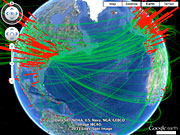- Number 353 |
- January 2, 2012
Is sustainability science really a science?
Los Alamos and Indiana University researchers say yes

The maps show number of
authors in cities worldwide
(red columns) and their
coauthorship networks (green
lines). Thicker lines indicate a
greater number of
collaborations between places.
The idea that one can create a field of science out of thin air, just because of societal and policy need, is a bold concept. But for the emerging field of sustainability science, sorting among theoretical and applied scientific disciplines, making sense of potentiallydivergent theory, practice and policy, the gamble has paid off.
In a recent issue of the Proceedings of the National Academy of Sciences, scientists from Los Alamos National Laboratory, Santa Fe Institute, and Indiana University analyzed the field’s temporal evolution, geographic distribution, disciplinarycomposition, and collaboration structure.
“We don’t know if sustainability science will solve the essential problems it seeks to address, but there is a legitimate scientific practice in place now,” said Luís Bettencourt of Los Alamos National Laboratory and Santa Fe Institute, first author on the paper, “Evolution and structure of sustainability science.”
The team’s work shows that although sustainability science has been growing explosively since the late 1980s, only in the last decade has the field matured into a cohesive area of science. Thanks to the emergence of agiant component of scientific collaboration spanning the globe and an array of diverse traditional disciplines, there is now an integrated scientific field of sustainability science as an unusual, inclusive, and ubiquitous scientific practice.
The researchers used an exhaustive literature search to determine if the field can truly be categorized as a legitimate science, using population modeling and documenting technical papers’ evolution over time, worldwide author distribution, range of sciences involved, and the collaboration structure of the participants. Many of these techniques form the basis of a new science of science, which allows researchers to analyze and predict the development of scientific and technological fields.
The researchers ask, “How has it been changing, and who are its contributors in terms of geographic and disciplinary composition? Most important, is the field fulfilling its ambitious program of generating a new synthesis of social, biological, and applied disciplines, and is it spanning locations that have both the capabilities and needs for its insights?”
Bettencourt said that they concluded that the field is both applied and basic, spanning worldwide institutions, governments, and corporations, but the key is the collaboration network that evolved in about the year 2000. “This has never been done, starting a worldwide scientific field defined mainly by the need for informed global social practice and policy,” Bettencourt said, “but sustainability science shows that it can be done.”.
[Nancy Ambrosiano, 505-667-0471,
nwa@lanl.gov]
http://www.lanl.gov/news/releases/is_sustainability_science_really_a_science.html
